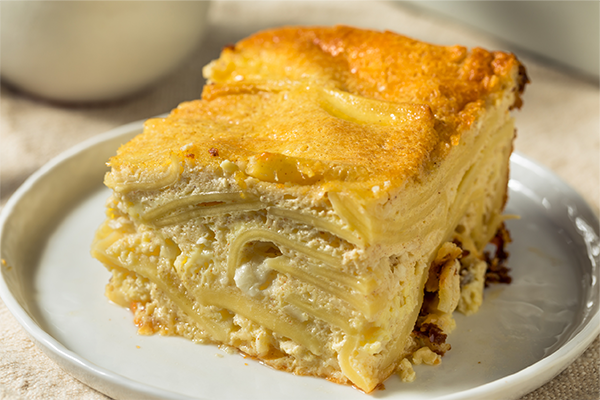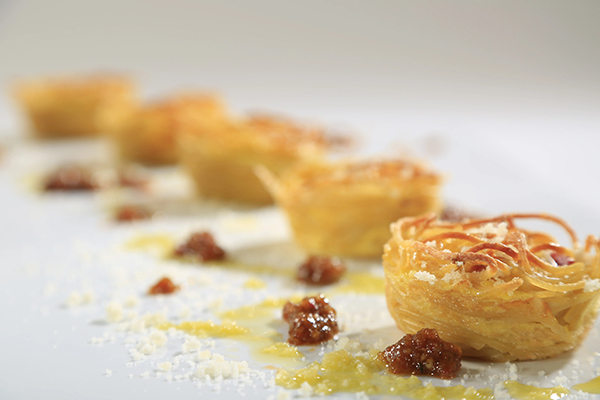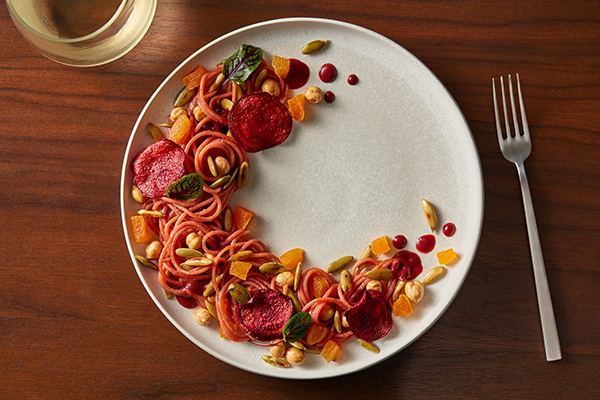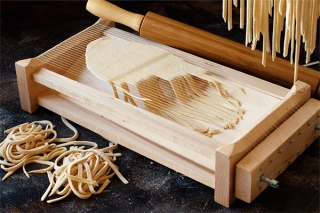Here’s a game you can play with your culinary students: Guess the ingredient. Look at the question list and see how you do:
What ingredient is:
- found in applications across all day and menu parts?
- at home in both savory and sweet applications?
- consumable hot or utilized as a cold leftover ingredient (increasing its sustainability factor)?
- comes in a variety of widths and lengths?
- found in global cuisines such as Japanese, Latin American and Italian?
- extremely economical?
- known to 96% of consumers and 88% report they either like it or love it?
The answer: spaghetti.
Consumers rate spaghetti as the most recognizable pasta shape and it has the highest penetration in US restaurants of all pasta shapes (Dataessential, 2025). Help culinary students go beyond spaghetti and meatballs to unlock their creativity and build their knowledge base of this well-known ingredient.
 Spaghetti across menu and day parts
Spaghetti across menu and day parts
The long, thin pasta noodle is found in sweet applications that can be served for breakfast or as a dessert. A noodle kugel is an Ashkenazi Jewish casserole made with noodles, dairy, raisins or other dried fruits, traditionally topped with cinnamon streusel and baked in either a casserole dish or ramekins. A sweet Hungarian version of the dish features angel hair pasta, curd, eggs, raisins and phyllo pastry sheets.
Desserts benefit from spaghetti broken into smaller pieces and folded into dishes such as chocolate flans, bread puddings or other baked applications. The smaller noodle pieces create optimal sauce absorption and a dense, uniform consistency in the applications. 
Sustainably utilizing cold, baked spaghetti, chefs can make a frittata perfect for a breakfast dish or made into smaller portions for appetizers or catered events.
Unexpected international cuisines featuring spaghetti
Every chef and consumer expects to find pasta in Italian dishes; this is not surprising in the least. But what about pasta in Japanese cuisine? The soba noodle made from buckwheat flour can be served hot or cold with a dipping sauce. Toppings vary but often include green onions, wasabi, nori, tempura and various meats. Whole grain pasta works well as a stand-in for soba noodles and brings its earthy, nutty flavors to a dish. Naporitan is a Japanese pasta dish featuring spaghetti cooked with ketchup-based sauce and ingredients like sausage, bacon, bell peppers and onions.
 Barilla for Professionals recently selected Johnson and Wales culinary student Josue Angel Cervantes’s Mole Rosa en Otono as their third-place winner of a recipe contest. The judges asked students to use ingredients including fruits, vegetables, high-quality grains, legumes, fish, healthy oils and a reduced amount of animal fat. “His spaghetti dish with traditional mole ingredients is beautiful on the plate and shows how adaptable this beloved pasta shape can be,” said Barilla Executive Chef of America Lorenzo Boni.
Barilla for Professionals recently selected Johnson and Wales culinary student Josue Angel Cervantes’s Mole Rosa en Otono as their third-place winner of a recipe contest. The judges asked students to use ingredients including fruits, vegetables, high-quality grains, legumes, fish, healthy oils and a reduced amount of animal fat. “His spaghetti dish with traditional mole ingredients is beautiful on the plate and shows how adaptable this beloved pasta shape can be,” said Barilla Executive Chef of America Lorenzo Boni.
In Peru, tallarines perde or green spaghetti is a dish incorporating thick spaghetti noodles served in a green sauce. The Peruvian pesto sauce is made with local ingredients such as queso blanco or queso fresco, fresh spinach and basil.
Lengths and widths of the popular pasta
Most commercial spaghetti varieties are the same length, cut so they will fit in standard packaging. Barilla’s regular number 5 spaghetti is 25cm long, which is typical. The length can be cut down from 25cm depending on the application’s requirements. There are various types of noodle widths, such as:
- Thin spaghetti or spaghettini is delicate and pairs well with lighter sauces
- Thick spaghetti or spaghettoni has more body and mouthfeel and pairs well with chunkier, meaty sauces or ragus
- Spaghetti alla chitarra, found in Italy, is traditionally made on a chitarra, a device with guitar-like strings, where the strands are square and not round
- Spaghetti rigati is a spaghetti with a ridge along its length
- Bucatini is a thick spaghetti with a buco or hole down the middle, which is good for trapping sauce and adding texture
- Fideo – also called cut spaghetti – it’s a spaghetti noodle pre-cut into small sections, popular for kids and soups. It’s very traditional in Latin America.
Why so popular everywhere?
Spaghetti is a versatile noodle that pairs well with nearly any sauce and ingredient. It has comfort food appeal which is affordable and easily prepared. According to Chef Boni, diners love the density of spaghetti in their mouth. “In my opinion, that is the main reason why spaghetti is the most-loved cut of pasta in the world,” he said.
Chef noted that there is a reason why there are spaghetteria – Italian restaurants that only serve spaghetti served in different ways - something that would be unthinkable for any other cut of pasta.
“Given that, it makes sense to exploit its full potential and unlock your (students’) creativity,” he said.
